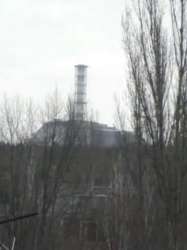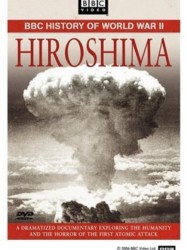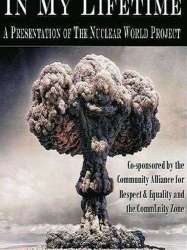Les films ayant le thème "Documentaire sur le nucléaire", triés par recette

White Horse (2008)
, 18minutesOrigine Etats-Unis
Genres Documentaire
Thèmes L'environnement, Documentaire sur l'environnement, Documentaire historique, Documentaire sur le nucléaire, Documentaire sur les technologies, Film catastrophe
The beginning of the film starts with DeLeo, Bisson and Surkov driving through Kiev. This is introduced as the beginning of their journey to Pripyat, near the ground zero of Chernobyl. Once they reach the outpost outside the exclusion zone, we see that the area surrounding Pripyat is very deserted and dark. Once in the city, we see Surkov's old home, which he explains has been robbed of almost all its belongings due to looters. Yet there are still some mementos in the old apartment, including the wallpaper he and his mother put up, the training bars his father bought for him, an old rubber ball he claims was his favorite and a white horse poster plastered on the wall of his old bedroom. The pain he feels is evident. When he sees an old calendar on a door, he rips a large portion off, claiming "the year ended on April 26th". Outside the door of the apartment, he remarks how he wishes he could stay forever. He throws his old ball through the door and walks out of the apartment complex. The film ends with Surkov snapping some twigs in an old courtyard and then an image of the car they traveled in leaving the exclusion zone.

Into Eternity (2010)
, 1h15Réalisé par Michael Madsen
Origine Italie
Genres Documentaire
Thèmes L'environnement, Documentaire sur l'environnement, Documentaire sur le nucléaire, Documentaire sur les technologies
La génération d'électricité via les centrales nucléaires produit des déchets dont on ne peut se débarrasser aisément et qu'on ne peut rendre inoffensifs. On estime aujourd'hui leur quantité à plus de 250 000 tonnes. Plusieurs solutions ont été considérées, telles que leur éjection hors de l'atmosphère terrestre, mais aucune ne présente à la fois un caractère durable et sûr. Invisible à l'œil nu, les radiations rendent ces matériaux dangereux sur une période d'au moins 100 000 ans. La majorité d'entre eux sont actuellement stockés dans des bassins remplis d'eau qui bloquent les radiations. Cependant, cette solution ne peut être que temporaire.

The Unnamed Zone (2006)
, 1h20Réalisé par Carlos Rodríguez
Genres Documentaire
Thèmes L'environnement, Documentaire sur l'environnement, Documentaire historique, Documentaire sur le nucléaire, Documentaire sur les technologies, Film catastrophe
The Spanish film crew led by Carlos Rodriguez is following the life stories of three children - Lidia Pidvalna, Anastasia Pavlenko, and Andriy Kovalchuk - whose lives were drastically changed after an explosion at the Chernobyl Nuclear Power Station on April 26, 1986. Through the documentary, the children and their families "living perilously close to the exclusion zone around the destroyed station recount their fears, dreams, fantasies, and hopes for the future." Each child holds a "Chernobyl certificate" which bestows access to government grants and aid and is a gruesome reminder of their existential reality.

Bombes à retardement (2007)
, 46minutesRéalisé par Guylaine Maroist
Origine Canada
Genres Documentaire
Thèmes L'environnement, Politique, Documentaire sur l'environnement, Documentaire sur la guerre, Documentaire historique, Documentaire sur le nucléaire, Documentaire sur une personnalité, Documentaire sur la santé, Documentaire sur les technologies, Politique
Acteurs Vlasta Vrána, Réal Bossé
En 1957, 40 jeunes soldats canadiens sont envoyés au Nevada pour servir de cobayes humains. Ils seront exposés à des explosions nucléaires quatre fois plus puissantes que celle d'Hiroshima, et cela à moins de 1 000 mètres. Ces hommes seront victimes de radiations et certains de leurs enfants naîtront avec des malformations. Bombes à retardement révèle une page sombre de l'histoire militaire au Canada. Basé sur des films d'archives inédits, ce film fait revivre l'expérience des soldats qui sont suivis 50 ans plus tard dans leur quête de justice auprès du gouvernement canadien.
 , 1h48
, 1h48Réalisé par Nicole Le Garrec
Origine France
Genres Documentaire
Thèmes Documentaire sur le nucléaire
Acteurs Nicole Le Garrec
Plogoff, février 1980 : toute une population refuse l'installation d'une centrale nucléaire à quelques encablures de la Pointe du Raz, face à l'île de Sein. Nicole et Félix Le Garrec ont filmé jour après jour ces luttes quotidiennes et ont réalisé en 1981 un documentaire long métrage "Plogoff, des pierres contre des fusils".

A Day Called X (1957)
, 30minutesRéalisé par Harry Rasky
Origine Etats-Unis
Genres Science-fiction, Documentaire
Thèmes L'environnement, Documentaire sur l'environnement, Documentaire sur la guerre, Documentaire historique, Documentaire sur le nucléaire, Documentaire sur les technologies, Politique
Acteurs Glenn Ford

No More Hiroshima (1984)
Genres Documentaire
Thèmes L'environnement, La mer, Transport, Aviation, Documentaire sur l'environnement, Documentaire sur la guerre, Documentaire historique, Documentaire sur le nucléaire, Documentaire sur les technologies, Politique, Documentaire sur la Seconde Guerre mondiale

Missile (1988)
Réalisé par Frederick Wiseman
Genres Documentaire
Thèmes L'environnement, Documentaire sur l'environnement, Documentaire sur la guerre, Documentaire historique, Documentaire sur le nucléaire, Documentaire sur les technologies, Politique

Hiroshima (2005)
, 1h29Origine Royaume-uni
Genres Drame, Documentaire
Thèmes L'environnement, La mer, Transport, Aviation, Documentaire sur l'environnement, Documentaire sur la guerre, Documentaire historique, Documentaire sur le nucléaire, Documentaire sur les technologies, Politique, Documentaire sur la Seconde Guerre mondiale
Acteurs John Hurt, Ed Bishop, Katsumi Chō, Naoko Mori, Ian Shaw, Shane Rimmer
À 8h15 précises ce 6 août 1945, le monde a changé. 40.000 personnes trouvent instantanément la mort, mais ce sont bien 200.000 décès qui seront provoqués par l´explosion de la première bombe nucléaire sur Hiroshima, au Japon. Ce documentaire exceptionnel de 90 minutes n´est pas « Un énième film anti-guerre » déclare son réalisateur Paul Wilmshurst, « mais bien l´analyse neutre et objective d´une décision cruciale. Il ne s´agit pas d´être pro-américain ou pro-japonais, j´ai simplement voulu raconter la vérité. » Une vérité technologique, scientifique, militaire et politique qui se dessine dans les trois semaines précédant l´attaque, alors que le premier essai nucléaire vient de se dérouler dans le désert du Nouveau-Mexique, aux États-Unis. Le spectateur se retrouve alors dans la pièce où est prise la décision ultime, à bord de l´Enola Gay pendant son trajet fatidique, à l´intérieur de la bombe au moment de l´explosion, puis dans les rues dévastées d´Hiroshima.
 , 1h52
, 1h52Origine Etats-Unis
Genres Documentaire
Thèmes L'environnement, Documentaire sur l'environnement, Documentaire sur la guerre, Documentaire historique, Documentaire sur le nucléaire, Documentaire sur les technologies

Gentilly Or Not To Be (2012)
, 55minutesOrigine Canada
Genres Documentaire
Thèmes Politique, Documentaire sur le nucléaire, Documentaire sur la politique, Politique, Documentaire sur la politique du Québec
Le film Gentilly Or Not to Be pose la question suivante aux défenseurs du nucléaire et à ses détracteurs : au-delà des risques d’accidents et de gestion de déchets irradiés, quels sont les impacts du nucléaire sur la santé humaine? Les réalisateurs se demandent aussi s'il est préférable "d'aller de l’avant avec la réfection de Gentilly-2, ou bien profiter de l’occasion pour se tourner vers des sources d’énergie alternatives".

Targeting Iran (2013)
, 1h11Origine Etats-Unis
Genres Documentaire
Thèmes L'environnement, Documentaire sur l'environnement, Documentaire sur la guerre, Documentaire historique, Documentaire sur le nucléaire, Documentaire sur la politique, Documentaire sur les technologies, Politique

Чорнобиль.3828 (2011)
, 30minutesOrigine Ukraine
Genres Documentaire, Historique
Thèmes L'environnement, Documentaire sur l'environnement, Documentaire historique, Documentaire sur le nucléaire, Documentaire sur les technologies, Film catastrophe
Twenty-five years have passed since Valeriy Starodumov worked as a dosimeter scout in September 1986. Valeriy worked at the epicenter of the explosion, the reactor's operation area, which was the most radioactive part of the site. The protagonist, a direct participant in the operation, went to the roof himself and brought people there after a failed attempt to clear the area with robots. At the government level, it was decided to assign soldiers and cadets of military schools to the task of cleaning the roofs. Unique pictures of the events of 1986 are widely used in the film. "Chernobyl.3828" is dedicated to people who saved the world from the radioactive contamination at the cost of their health and life.

Le Pic-vert russe (2015)
, 1h20Origine Etats-Unis
Genres Documentaire, Historique
Thèmes L'environnement, Documentaire sur l'environnement, Documentaire historique, Documentaire sur le nucléaire, Documentaire sur les technologies, Film catastrophe
Le jeune artiste ukrainien Fedor Alexandrovitch et le réalisateur Chad Gracia enquêtent sur la catastrophe de Tchernobyl : et si ce n'était pas un accident ?

First Strike (1978)
Origine Etats-Unis
Genres Guerre, Documentaire
Thèmes L'environnement, Transport, Aviation, Documentaire sur l'environnement, Documentaire sur la guerre, Documentaire historique, Documentaire sur le nucléaire, Documentaire sur les technologies, Forces armées des États-Unis
The documentary is divided into two main segments. The first section of the film is a dramatization of a sneak attack by Soviet Union nuclear weapons against the United States. The premise of the attack is based on Soviet nuclear submarines approaching the United States west coast undetected and launching a barrage of missiles at ICBM silos and B-52 bomber bases, while other Soviet forces manage to destroy a number of U.S. ballistic missile submarines at sea. In the film, by the time Strategic Air Command realizes what is happening, over 80% of U.S. strategic forces have been destroyed and the President of the United States is forced to surrender to the Soviet Union. American casualties are stated to be eight million dead - this "low" number is due to the Soviet attack hitting military bases instead of cities.
 Connexion
Connexion